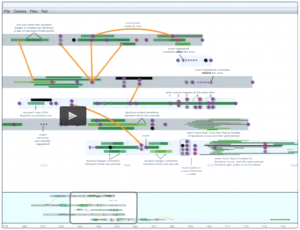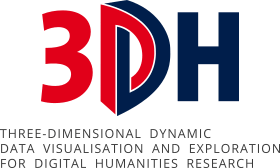
Stan Ruecker gave the 3DH talk on the 23rd of June with the enigmatic title The Digital Is Gravy. He explained the title in reference to gravy being the what gives flavour to the steak. In his case, he wanted to show us how physical prototyping can give substance (steak) to the digital.
Stan started with an example of a physical prototype that materializes bubblelines that was developed by Milena Radzikowska who showed it at Congress 2016 in Calgary. (See Materializing the Visual.) He suggested that materialization of a visualization slows down analysis and leads to other lines of thought.
At the IIT Institute for Design Stan is weaving physical prototyping into digital design projects. His main research goal is to find ways to encourage people to have multiple opinions. He want to build information systems that encourage the discovery of different perspectives and the presentation of multiple opinions on a phenomenon. The idea is to encourage reflective interpretation rather than dogmatism.
How prototypes build understanding
He listed some ways that prototyping can build understanding:
- Build something to collect information
- The prototype is itself a kind of evidence
- Learning through making. You don’t even need to finish a prototype. “Fail early and fail often.”
- Prototype is also a representation of the topic area
Why physicality is important
After returning to the materialized bubblelines he talked
- Materialized prototypes take time differently which can lead
- It can produce results that can be used for comparison (with other results)
- It can engage physical intelligence – embodied experience can leverage different ways of knowing
- It involves collaboration (over time) that involves community knowing
- It encourages multiple perspectives from different people and different points of view
My experience with the pleasures of physical prototyping in a group reinforces the way the making of the
Timelines
He then talked about a project around timelines that has built on work Johanna Drucker did. He had gone through multiple prototypes from digital to physical as he tried to find ways to represent different types of time. He tried creating a 3D model in Unity but that didn’t really work for them. He now has a number of student designers who are physically modelling what the timeline could be like if you manipulated it physically and then that was uploaded to the digital representation (the gravy.)
Physical Qualitative Analysis
He then talked about how a multinational team is designing physical analytical tools. The idea is that people can analyze a text and model an understanding of it in a physical 3D space. It is grounded theory – you build up an emergent understanding. They tried creating a floating model like a Calder sculpture. They tried modelling technical support conversations. They used a wired up coat rack – hacking what they had at hand.
My first reaction is that doing this physically would be so slow. But that is the point. Slow down and think by building. They tried a digital table and that was no fun so they started making all sorts of physical
I’m guessing it would be interesting to look at Ann Blair’s Too Much To Know where she talks about the history of note taking and physical ways of organizing information like excerpt cabinets.
Stan then talked about a successful line of prototypes that had transparent panels that could be organized, joined, and on which ideas could be put with post-it notes. Doing this in a team encourages users to different views on a subject as the panels have two sides and can be jointed to have even more.
Finally, they are now trying to bring these back to the digital so that once you have an arrangement of panels with notes you can digitize it and bring it into the computer. This also suggests the possibility of automatically generating the model on the computer from the text.
He commented on how he has no industry industry interested in the analysis of conversations.
And that was the end.

